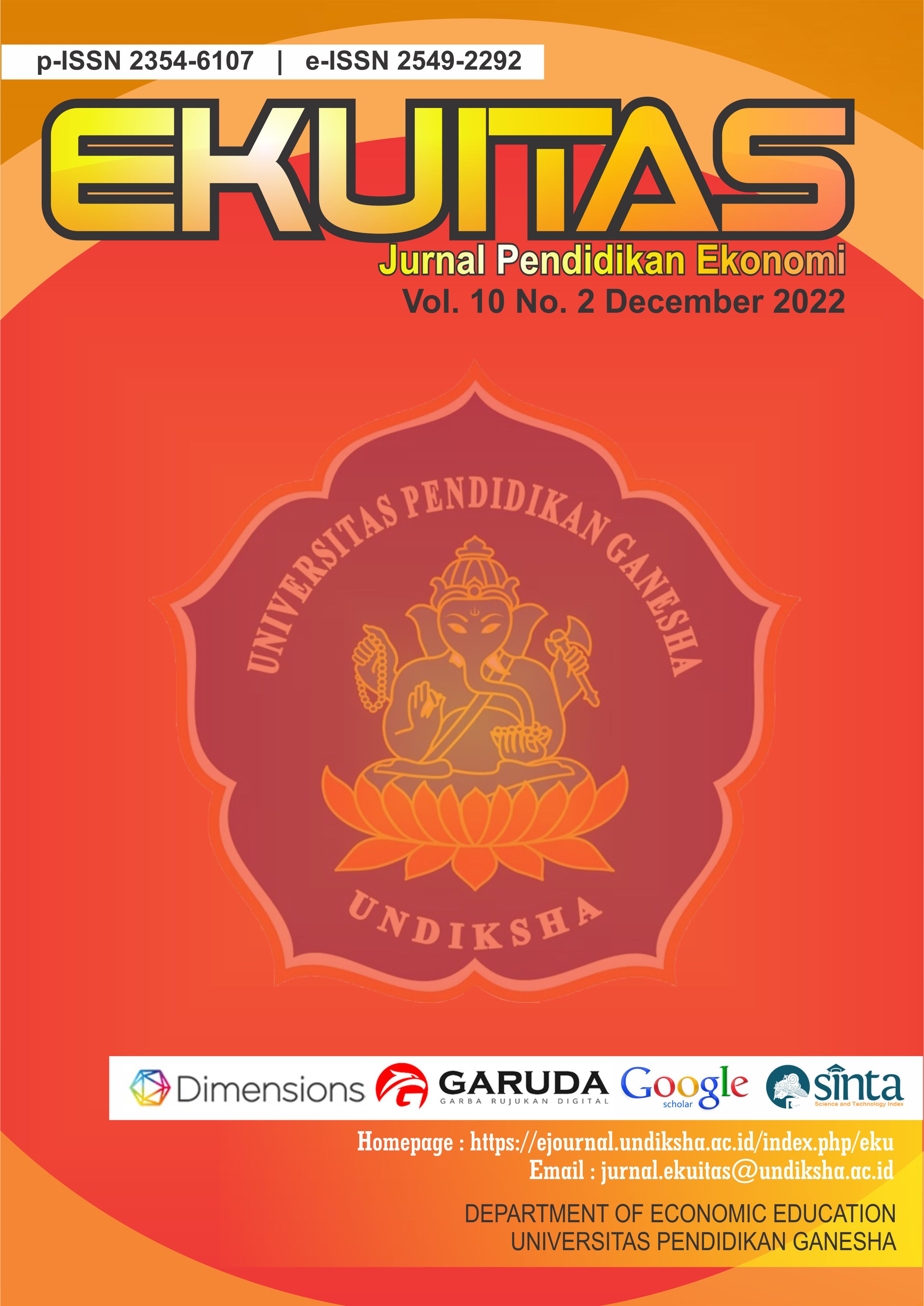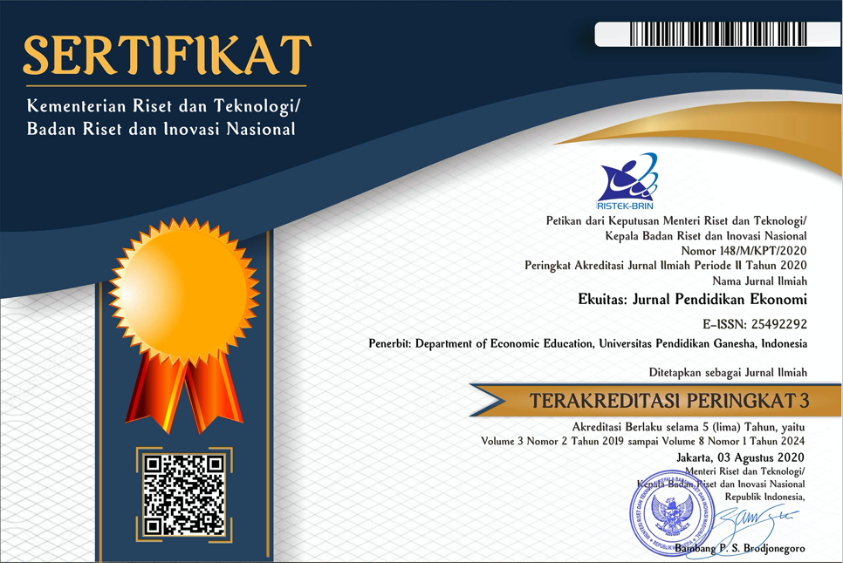The Effect of Work-Life Balance and Career Development on Employee Performance
DOI:
https://doi.org/10.23887/ekuitas.v10i2.54292Kata Kunci:
Career development, and employee performance., PT. bank tabunganpensiunan nasional (BTPN) branch kupang, work-life balanceAbstrak
This study aims to (1) describe work-life balance, career development, and employee performance at PT. National Pension Savings Bank (BTPN) Kupang Branch (2) significant effect of work-life balance on employee performance at PT. National Pension Savings Bank (BTPN) Kupang Branch (3) significant influence of career development on employee performance at PT. National Pension Savings Bank (BTPN) Kupang Branch (4) the effect of work-life balance and development on the performance of employees of PT. Kupang branch of the National Pension Savings Bank (BTPN). There were 36 samples in this study which were obtained using the Slovin formula and the sampling technique used random sampling technique. The data analysis method used is quantitative analysis using validity and determinant coefficient tests. The results of the research using descriptive analysis using a range of scores for the work-life balance variable are in the very high category, while career development and employee performance are in the high category. Work-life balance partially affects employee performance, career development partially affects employee performance, and work-life balance and career development simultaneously affect employee performance.
Referensi
Bangun, W. (2012). Manajemen Sumber Daya Manusia. Jakarta: Erlangga. Internatinal Journal, 4.
Busro, M. (2018). Teori-teori manajemen sumber daya manusia. Prenada Media.
Cahyono, S. (2005). Pengaruh Budaya Organisasi, Kepemimpinan Dan Motivasi Kerja Terhadap Kinerja Sumberdaya Manusia Di Sekretariat DPRD Propinsi Jawa Tengah, JRBI, Vol. 1. In Jurnal Riset Bisnis Indonesia (Vol. 1, Issue 1).
Danang, S. (2012). Manajemen Sumber Daya Manusia. In Jakarta: PT Buku Seru.
Delecta, P. (2011). Work life balance. International Journal of Current Research, 3(4), 186–189.
Hasibuan, Malayu Sp. 2012. Manajemen SDM. Edisi Revisi, Cetakan Ke Tigabelas. Jakarta : Bumi Aksara.
Hudson, R. (2005). The case for work-life balance: Closing the gap between policy and practice. Hudson Highland Group.
Hutcheson, P. G. (2012). Work Life Balance-Book 1.
Kadarisman, M. (2012). Manajemen pengembangan sumber daya manusia. In Jakarta: Rajawali Pers (Vol. 2).
Lockwood, N. R. (2003). Work/life balance. Challenges and Solutions, SHRM Research, USA, 2–10.
Mardiani, I. N., & Widiyanto, A. (2021). Pengaruh work-life balance, Lingkungan Kerja dan Kompensasi terhadap Kinerja karyawan PT Gunanusa Eramandiri. Jesya (Jurnal Ekonomi & Ekonomi Syariah), 4(2), 985–993. https://doi.org/10.36778/jesya.v4i2.456
Marwansyah. (2014). Manajemen Sumber Daya Manusia-Edisi Kedua. In Alfabeta.
Mendrofa, Y., & Nazara, D. S. (2021). Pengaruh Pengembangan Karir Terhadap Kinerja Karyawan Perusahaan Umum Daerah Pasar Ya’Ahowu Kabupaten Nias. JURNAL AKUNTANSI DAN MANAJEMEN PEMBNAS, 8(1), 45–55.
Parkes, L. P., & Langford, P. H. (2008). Work–life bal ance or work–life alignment? A test of the importance of work-life balance for employee engagement and intention to stay in organisations. Journal of Management & Organization, 14(3), 267–284.
Paul, A. K., & Anantharaman, R. N. (2003). Dampak Praktek Manajemen Orang pada Kinerja Organisasi: Analisis Model Kausal. International Juornal of Manajemen Sumber Daya Manusai, 156, 1246–1266.
Perangin Angin, I. I., & Saragih, E. H. (2021). Pengaruh Work Life Balance terhadap Kinerja Karyawan Generasi X dan Y di Jakarta. Journal of Emerging Business Management and Entrepreneurship Studies, 1(1), 48–57.
Rivai, V. (2009). Manajemen sumber daya manusia untuk perusahaan: Dari teori ke praktik. Rajawali Pers.
Rivai, V., & Sagala, E. J. (2013). Manajemen Sumber Daya Manusia untuk Perusahaan Edisi 3. Rajawali Pers.
Robbins, S. P., & Judge, A. T. (2011). Organizational behavior. Pearson Education. New Jersey, 7458, 77–89.
Sihotang, A. (2006). Manajemen Sumber Daya Manusia (Cetakan 1),. In PT. Pradenya paramitha.
Singh, P., & Khanna, P. (2011). Work-Life Balance–A Tool for Increased Employee Productivity and Retention. Lachoo Journal of Management, 2(2), 1–9.
Sugiyono, P. D. (2017). Metode Penelitian Bisnis: Pendekatan Kuantitatif, Kualitatif, Kombinasi, dan R&D. Penerbit CV. Alfabeta: Bandung.
Sutrisno, E. (2016). Manajemen Sumber Daya Manusia Kencana Prenada. Media Group. Jakarta.
Suwatno, H. d, & Priansa, D. J. (2011). Manajemen SDM dalam organisasi Publik dan Bisnis.
Wambui, M., Cherotich, B., & Emily, T. (2015). Effects of worklife balance on employees performance in institutions of higher learning. Kabarak Journal of Research & Innovation, 60–79









